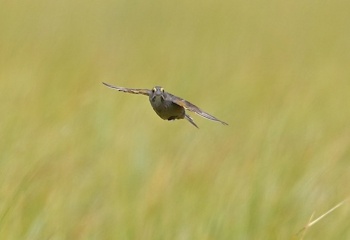- Ammospiza maritima
Ammodramus maritimus
Identification
12·5–15 cm (5-6 in)
- Brown upperparts
- Grey crown and nape
- Greyish-buff breast with dark streaks
- Dark face
- Long, narrow, conical bill
- Grey cheeks
- Small yellow streak just above the eye
- White throat
- Short pointed tail
Sexes similar
Similar Species
Nelson's Sparrow and Saltmarsh Sparrow both have more orange colors in head and/or breast.
Distribution
Coastal eastern and gulf coast United States.
Taxonomy
Subspecies

Photo © by Stanley Jones
Anahuac National Wildlife Refuge, Chambers County, Texas, USA, May 2018
This is a polytypic species consisting of 7 subspecies[1]:
- A. m. maritimus:
- Salt marshes from Massachusetts to northern North Carolina; winters to north0eastern Florida
- A. m. macgillivraii:
- Salt marshes from northern North Carolina to southern Georgia (formerly to northern Florida)
- A. m. nigrescens: Dusky Sparrow
- Salt marshes of eastern coastal and eastern Florida. Extinct
- A. m. fisheri:
- Marshes of Gulf Coast (San Antonio Bay to Alabama)
- A. m. sennetti:
- Marshes of Gulf Coast of southern Texas (Aransas County to Nueces Bay)
- A. m. peninsulae:
- Salt marshes of western Florida (Dixie County to Old Tampa Bay) and Gulf Coast of northern Florida (Escambia County to Taylor County)
- A. m. mirabilis:
- Marshes of south-western Florida (Everglades to Cape Sable)
Habitat
Salt marshes, both edges and interior. Likes the wettest and muddiest areas.
Behaviour
Breeding
The construct an open cup nest on tidal reeds and spartina grasses. The clutch consists of 2-5 eggs.
Diet
Their diet consists mostly of animal matter; such as marine insects, small snails and crabs.
References
- Clements, J. F., T. S. Schulenberg, M. J. Iliff, D. Roberson, T. A. Fredericks, B. L. Sullivan, and C. L. Wood. 2018. The eBird/Clements checklist of birds of the world: v2018. Downloaded from http://www.birds.cornell.edu/clementschecklist/download/
- Handbook of the Birds of the World Alive (retrieved July 2016)
Recommended Citation
- BirdForum Opus contributors. (2025) Seaside Sparrow. In: BirdForum, the forum for wild birds and birding. Retrieved 15 May 2025 from https://www.birdforum.net/opus/Seaside_Sparrow
External Links
GSearch checked for 2020 platform.





